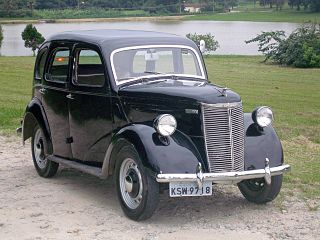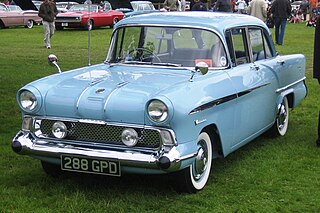
The Firenza is a model of car offered by Vauxhall from May 1971 until 1975. It was a development of the Viva, but had a distinctive coupé body style (fastback) and only two doors. In South Africa, it was sold as the Chevrolet Firenza until it was replaced by the Chevrolet 1300/1900 during 1975. Its name is derived from Firenze, the name of the Italian city known in English as Florence.

The Ford Prefect is a line of British cars which was produced by Ford UK between 1938 and 1961 as an upmarket version of the Ford Popular and Ford Anglia small family cars. It was introduced in October 1938 and remained in production until 1941. Returning to the market in 1945, it was offered until 1961. The car progressed in 1953 from its original perpendicular or "sit-up-and-beg" style to a more modern three-box structure. Some versions were also built and sold by Ford Australia.

The Opel Rekord is a large family car which was built in eight generations by the German car manufacturer Opel. Between 1953 and 1986, approximately ten million were sold.

The Peugeot 404 is a large family car produced by French automobile manufacturer Peugeot from 1960 to 1975. A truck body style variant was marketed until 1988. Styled by Pininfarina, the 404 was offered initially as a saloon, estate, and pickup. A convertible was added in 1962, and a coupé in 1963. The 404 was fitted with a 1.6 litre petrol engine, with either a Solex carburetor or Kugelfischer mechanical fuel injection or a 1.9 litre diesel engine available as options. Introduced at the Paris Motor Show as an option was the inclusion of a 3-speed ZF automatic transmission, similar to the unit already offered on certain BMW models, as an alternative to the standard column-mounted manual unit.

The Vauxhall Victor is a large family car produced by Vauxhall from 1957 until 1976. The Victor was introduced to replace the outgoing Wyvern model. It was renamed Vauxhall VX Series in 1976 and continued in production until 1978, by which time it had grown significantly and was viewed, at least in its home market, as a larger-than-average family car.

The MGA is a sports car that was produced by MG from 1955 until 1962.

The Riley RM Series is an executive car which was produced by Riley from 1945 until 1955. It was the last model developed independently by Riley prior to the 1952 merger of Riley's still new owner Nuffield, with Austin to form BMC. The RM series was originally produced in Coventry, but in 1949 production moved to the MG works at Abingdon. The RM models were marketed as the Riley 1½ Litre and the Riley 2½ Litre.

The Austin Westminster series are large saloon and estate cars that were sold by the British manufacturer Austin from 1954, replacing the A70 Hereford. The Westminster line was produced as the A90, A95, A99, A105, and A110 until 1968 when the new Austin 3-Litre took its place. Essentially badge-engineered versions of the Farina Westminsters were also produced using the premium Wolseley and Vanden Plas marques. 101,634 Westminsters were built.

The Vauxhall Cresta is a British full-size car which was produced by Vauxhall from 1954 to 1972. The Cresta was introduced in 1954 as an upmarket version of the Vauxhall Velox, itself a six-cylinder version of the Vauxhall Wyvern. The Cresta models were the E (1954–1957), PA (1957–1962), PB (1962–1965) and PC (1965–1972). The Viscount (1966–1972) was an upmarket Cresta PC.

VXR is the branding for the high performance trim specification, used since 2004 for models in many of Vauxhall's car range in the United Kingdom. Holden has also used the VXR badge for some of its high-performance cars such as the Astra VXR, Insignia VXR, and the Commodore VXR.

The Bentley Mark VI is an automobile from Bentley which was produced from 1946 until 1952.

The Morris Six Series MS is a six-cylinder midsize car from Morris Motors Limited which was produced from 1948 to 1953. Announced with Morris Motors' Minor, Oxford and Wolseley ranges on Tuesday 26 October 1948, it was Morris's first post-war six-cylinder car. All the new cars were of integral construction of chassis and body and rode on independent front suspension with torsion bars. At launch, the car was priced at £607 on the UK market, though the price rose to £671 on 1 March 1949.

The Fiat 518, also called Fiat Ardita, was a model of car produced by Italian car manufacturer Fiat between 1933 and 1938. The name "Ardita" was also used on the six-cylinder engined and more expensive Fiat Ardita 2500 or 527.

The Standard Eight is a small car produced by the British Standard Motor Company from 1938 to 1959.

The Vauxhall Wyvern is a medium-sized family car introduced by Vauxhall in 1948 as a successor to the Vauxhall 12. The name comes from the mythical beast the wyvern, and may be due to a misidentification of the heraldic griffin on the Vauxhall badge.

The Alvis Fourteen also known as TA 14 was the first car to be produced by major defence contractor Alvis cars after World War II. The entire car factory had been destroyed on the night of Thursday 14 November 1940. Announced in November 1946 it was made until 1950 when its postwar austerity 1900 cc engine was replaced by the 2993 cc 26.25 HP Alvis Three Litre or TA 21.

The Vauxhall 30–98 is a car manufactured by Vauxhall at Luton, Bedfordshire from 1913 to 1927. In its day, its best-known configuration was the Vauxhall Velox standard 4-seater with open tourer body. Vauxhall's own description was the 30–98 hp Vauxhall-Velox sporting car. The 30–98 is also known to enthusiasts by Vauxhall's chassis code E.

The Vauxhall 25 h.p. chassis code D type is a car manufactured by Vauxhall from 1912 to 1922. More than 1,500 were supplied to the British Army in World War I for use as staff cars. Each Vauxhall chassis was sold with a three-year guarantee including regular inspections.

The Vauxhall Light 6 is an automobile which was produced by Vauxhall in the United Kingdom from 1933 to 1938.

The Vauxhall Big 6 is a name given to a series of automobiles which was produced by Vauxhall in the United Kingdom from 1934 to 1940. Rolling chassis were also bodied in Australia.





















